| Srl | Item |
| 1 |
ID:
151404
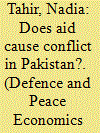

|
|
|
|
|
| Summary/Abstract |
This study provides evidence from Pakistan on how the delegated task of achieving strategic objectives of the donor can lead to incompatibility of aid objectives which then generates perpetual and multidimensional domestic conflict in the recipient society. We use count data method to estimate the relationship between aid and conflict. At the aggregate level, social sector spending, regime change and youth bulge are positively and significantly related with conflict. However, aid per capita gives ambiguous results. It is significant with conflict count in the terrorism data-set and insignificant for data on armed conflict. Inclusion of youth bulge and unemployment rate confirms the marginalization hypothesis of conflict. Inflation rate and the tax variables are insignificant. This confirms that aid erodes fiscal capacity. At project-level data, conflict is strongly related with aid commitment and purpose. Discrepancy in aid allocation and commitment may accentuate conflict.
|
|
|
|
|
|
|
|
|
|
|
|
|
|
|
|
| 2 |
ID:
156802
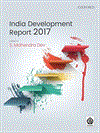

|
|
|
|
|
| Publication |
New Delhi, Oxford University Press, 2018.
|
| Description |
xxvi, 270 + A1.1-A9.2 p.: tables, figures, boxespbk
|
| Standard Number |
9780199483549
|
|
|
|
|
|
|
|
|
|
|
|
Copies: C:1/I:0,R:0,Q:0
Circulation
| Accession# | Call# | Current Location | Status | Policy | Location |
| 059258 | 338.954/DEV 059258 | Main | On Shelf | General | |
|
|
|
|
| 3 |
ID:
073731
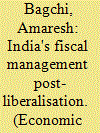

|
|
|
| 4 |
ID:
120920
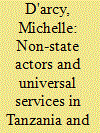

|
|
|
|
|
| Publication |
2013.
|
| Summary/Abstract |
In recent years over half of all African states have re-introduced some form of universal basic service provision, though many more have done so in education when compared with health. Most existing explanations of these developments have emphasised the importance of demand side factors associated with democratisation. This paper argues that while democratisation has been important in generating pressure for reform, alliances with actors outside the state - such as donors and non-state service providers - have been the critical enabling factor allowing weak states to overcome their capacity constraints and respond. Two illustrative case studies are used to show how variation in alliance opportunities has led to differences in outcomes both between social sectors and across countries. An inter-sector comparison of health and education policy in Tanzania shows how a difference in donor policy preferences between sectors - donors having converged behind the principle of universal primary education but not universal healthcare - has led to variation in alliance opportunities and hence policy outcomes. A 'least likely' case of healthcare reform in Lesotho shows how an alliance with a non-state provider has made difficult reforms possible.
|
|
|
|
|
|
|
|
|
|
|
|
|
|
|
|
| 5 |
ID:
183447
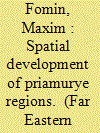

|
|
|
|
|
| Summary/Abstract |
This article discusses some relevant problems of the spatial development of Russian Priamurye, i.e., Khabarovsk Territory, Amur Region, and the Jewish Autonomous Region. The results of afield sociological study conducted by the authors in these regions in September 2020 are presented, as are some comparative data for social well-being of the northern and southern regions of the Far East according to the results of a survey taken in August and September 2019. A sample is constructed on the model using key features in their set and based on quota-proportional and territorial methods. The sample size is 659 respondents. The empirical object of the study is the regions' adult population. The social situation of Priamurye's population, their attitudes toward migration and toward labor migrants from abroad, the economic situation, and the development dynamics of key enterprises of the mezzoregion are considered. The article discusses the main causes of mass migration intentions. Also, social stratification in the regions and increasing income disparity are still serious problems. The population of Priamurye is acutely aware of increasing income disparity in the mezzoregion and points to the lack of social justice as an important factor motivating migration. Virtually, in order to retain and attract people to Priamurye, it is necessary to maintain a higher living standard in these regions than in European Russia. The remoteness of the Far East and its more severe climate require compensatory mechanisms in other areas, as well.
|
|
|
|
|
|
|
|
|
|
|
|
|
|
|
|
| 6 |
ID:
179235
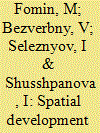

|
|
|
|
|
| Summary/Abstract |
This article deals with the current problems of spatial development in Primorye Territory and the Sakhalin Region. We present the results of sociological research conducted by the authors in these regions in September 2019. The sample was assembled from a model using the key characteristics of the general population, based on the principles of quota-proportional and territorial methods. The total excerpt size is 468 respondents. The empirical object of the study is the adult population of the regions.
|
|
|
|
|
|
|
|
|
|
|
|
|
|
|
|